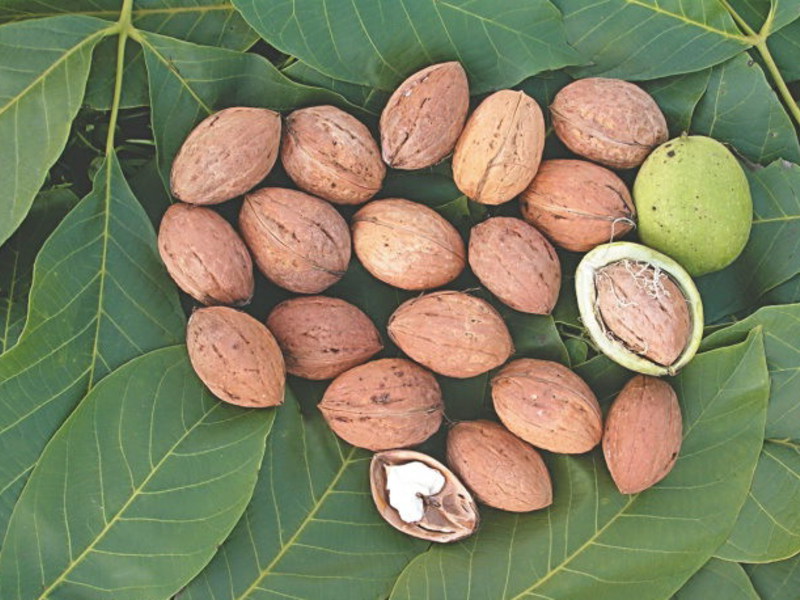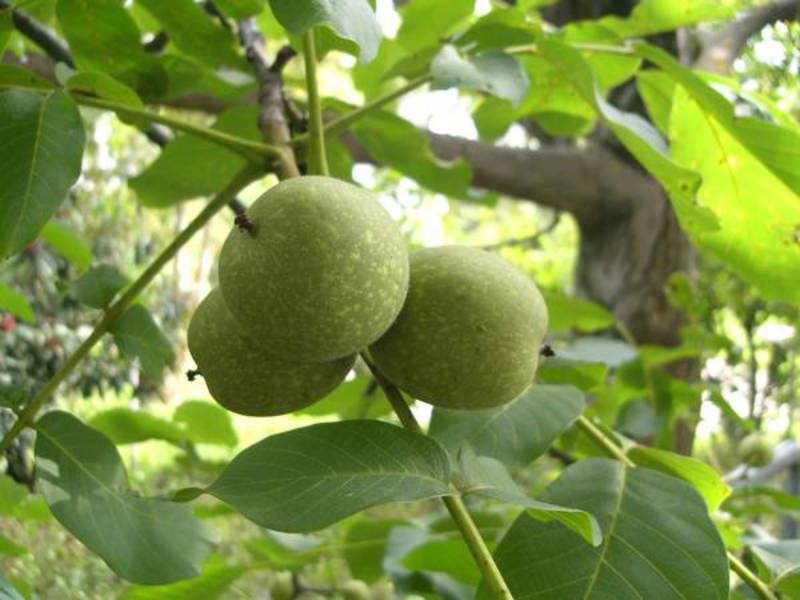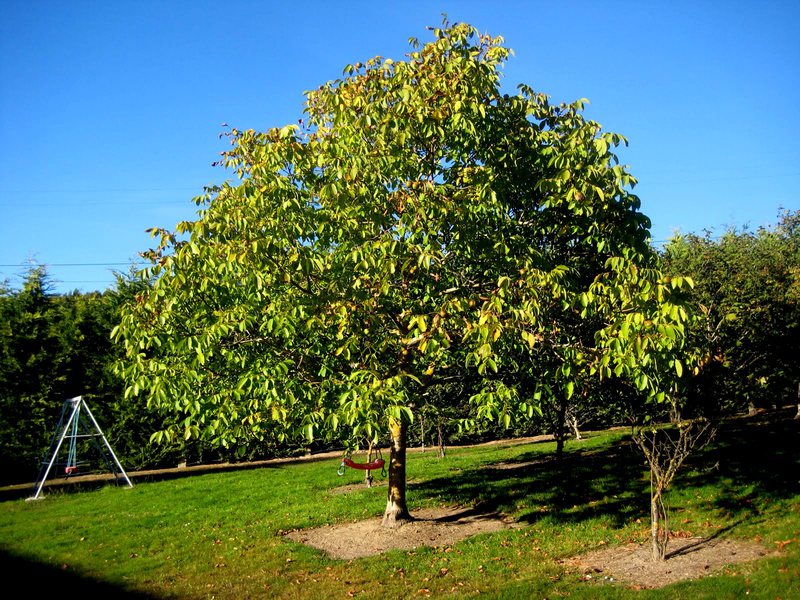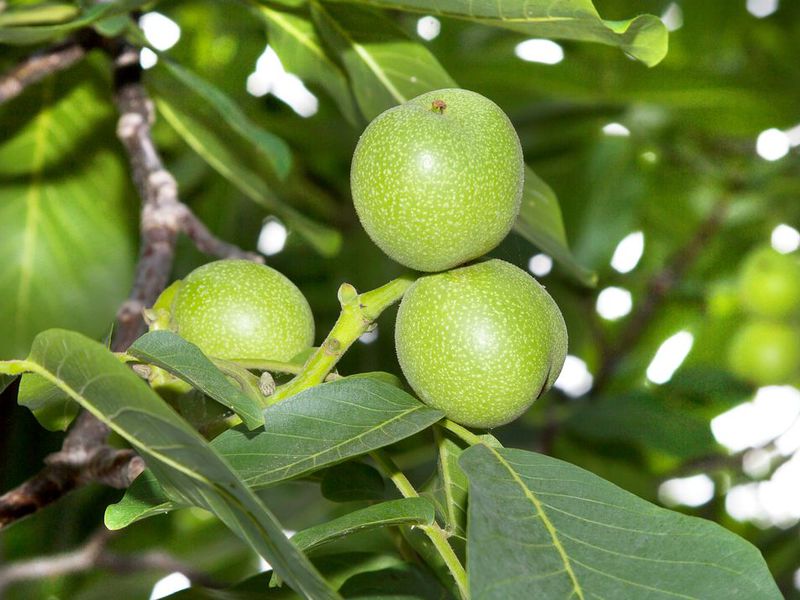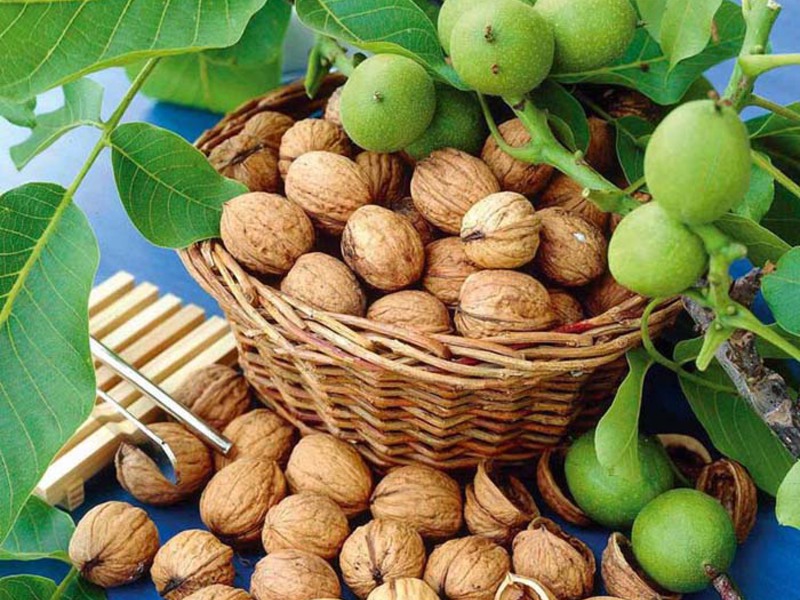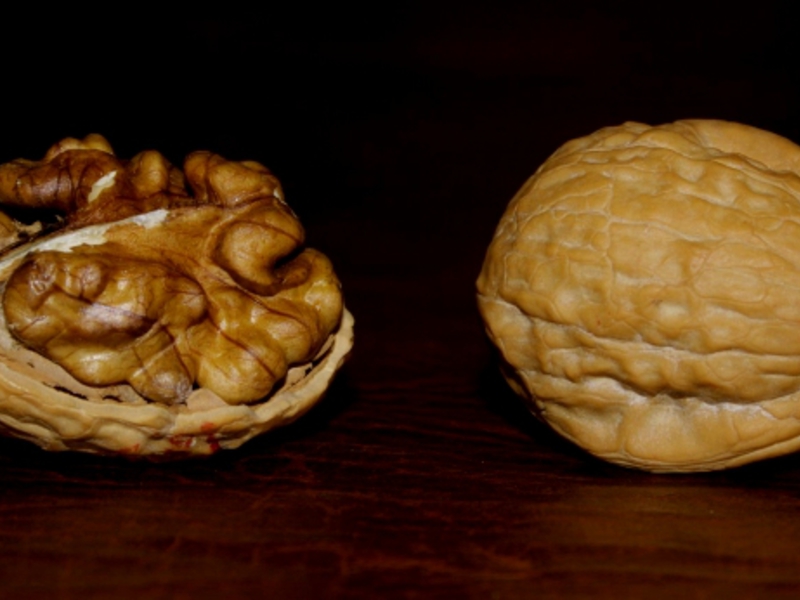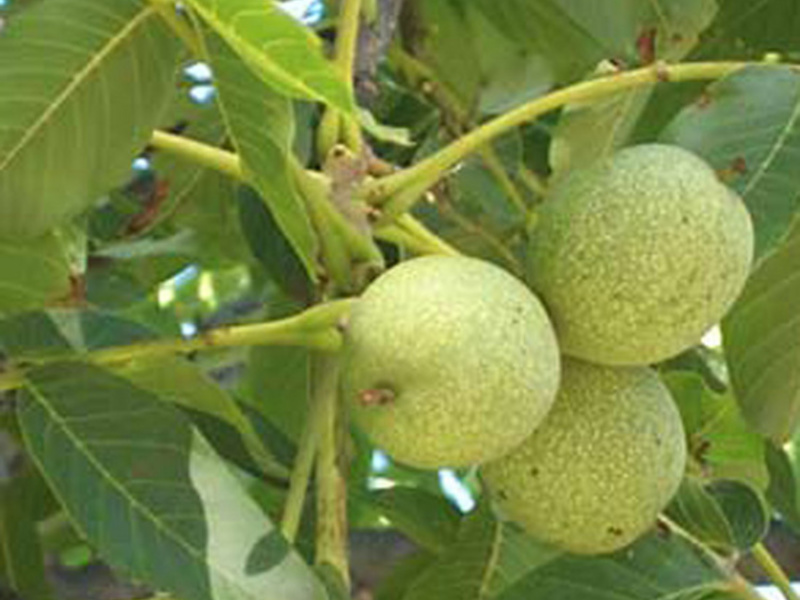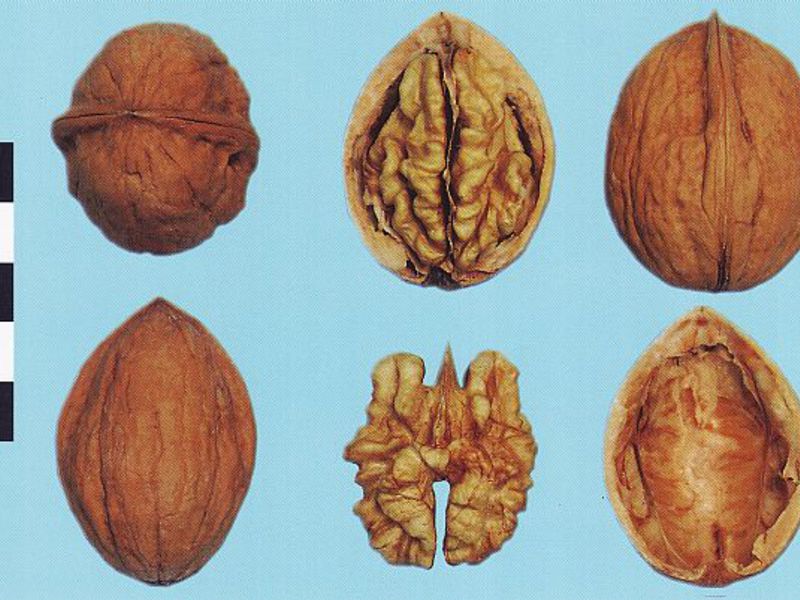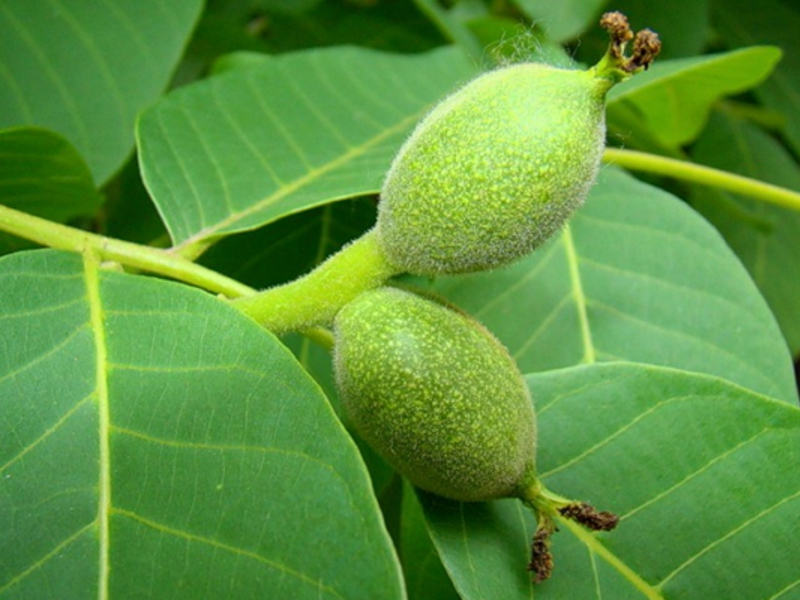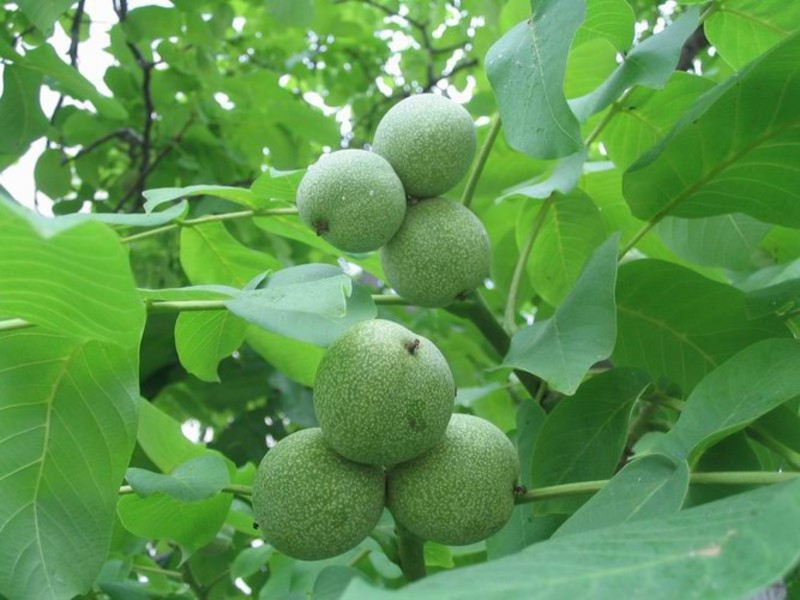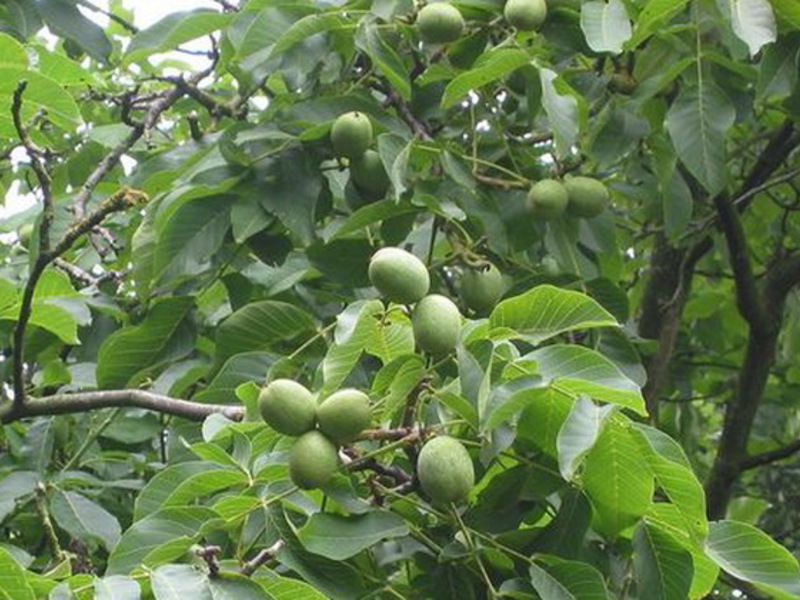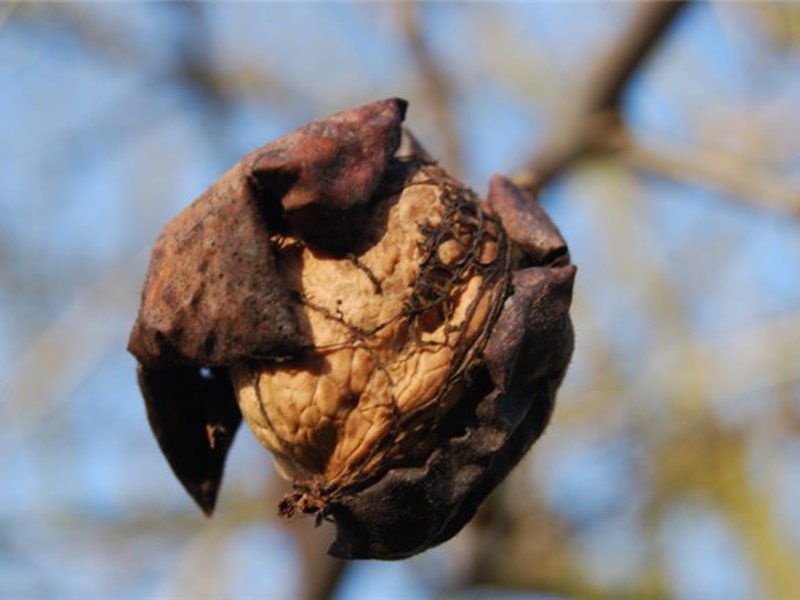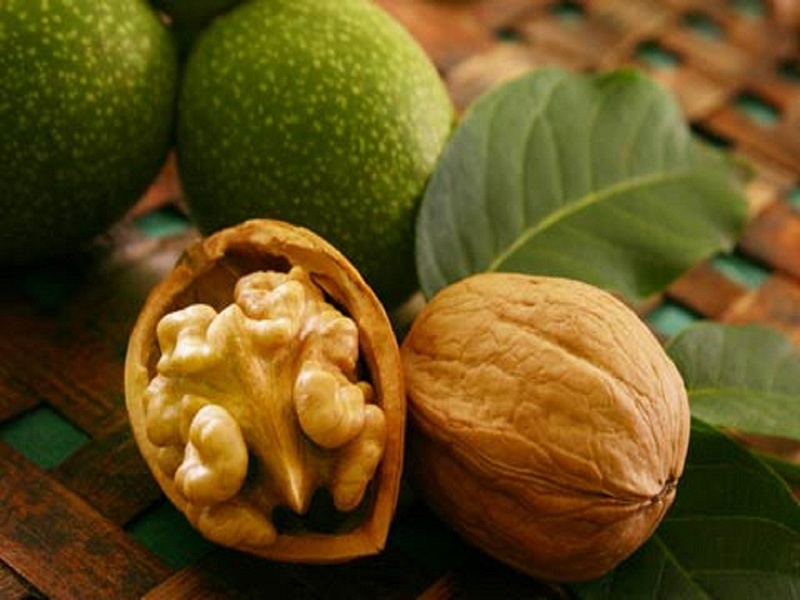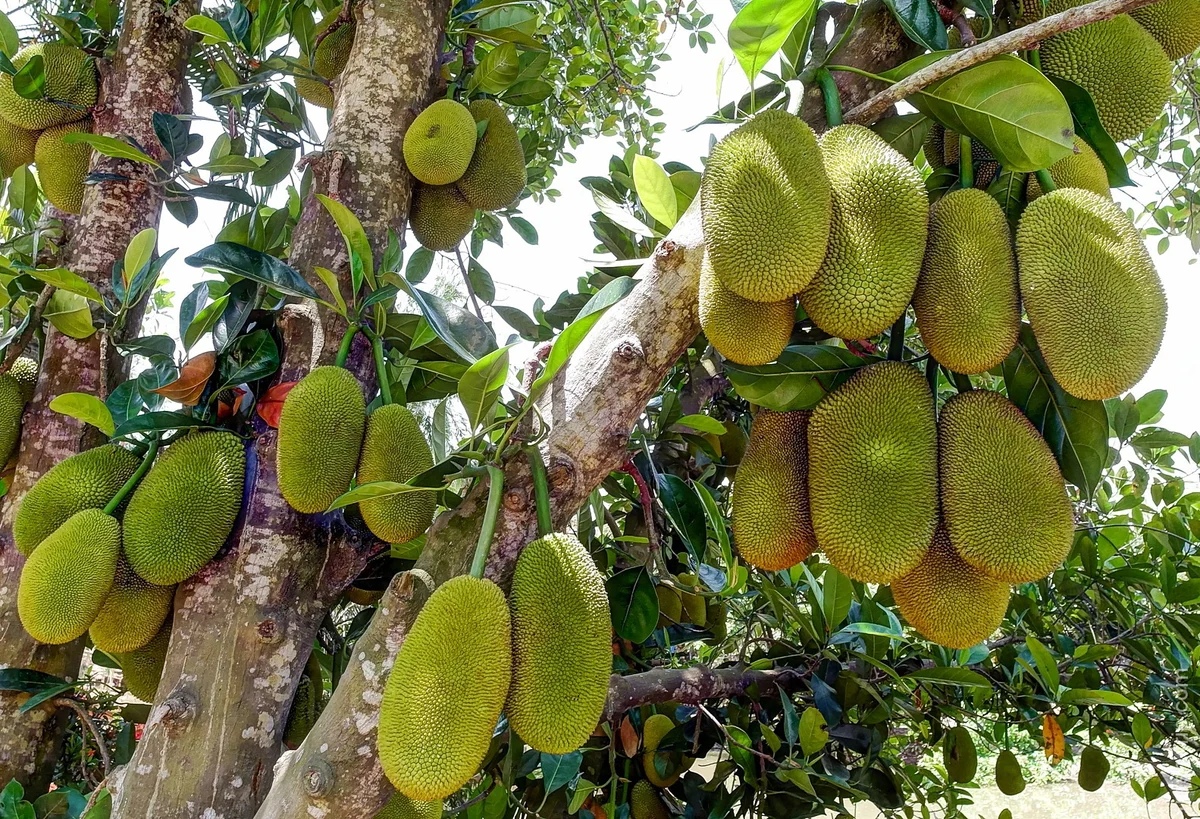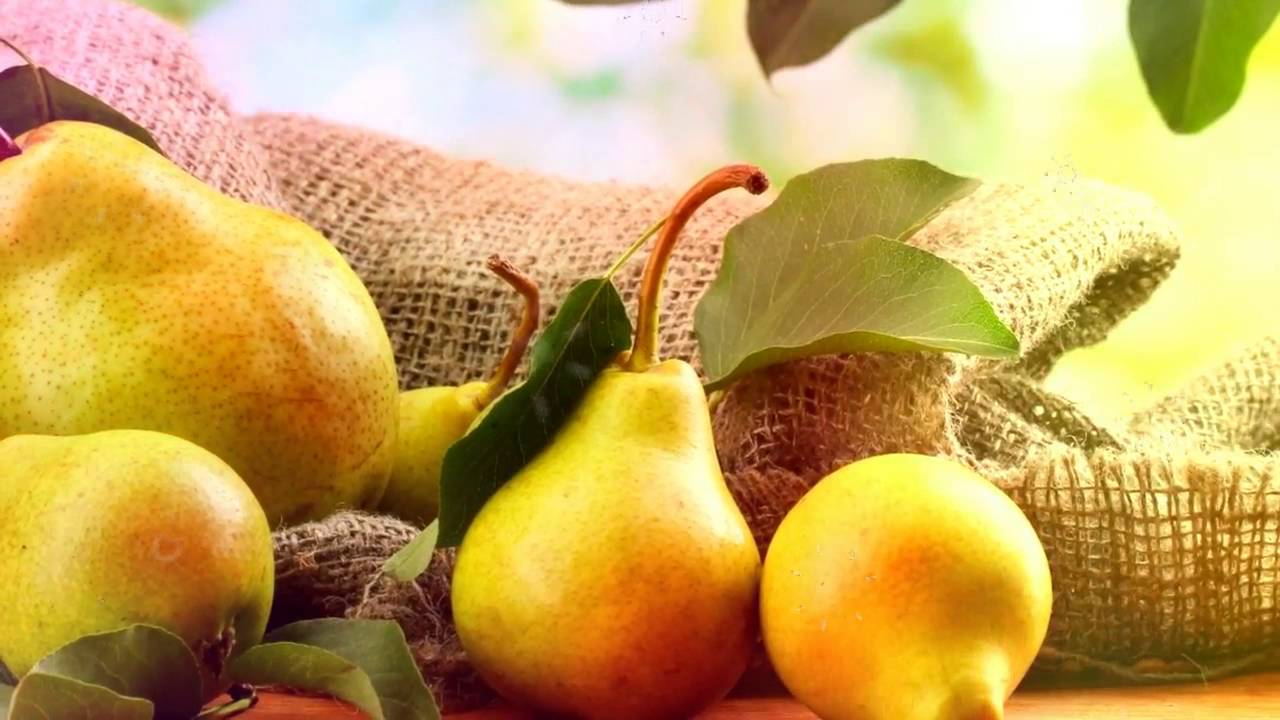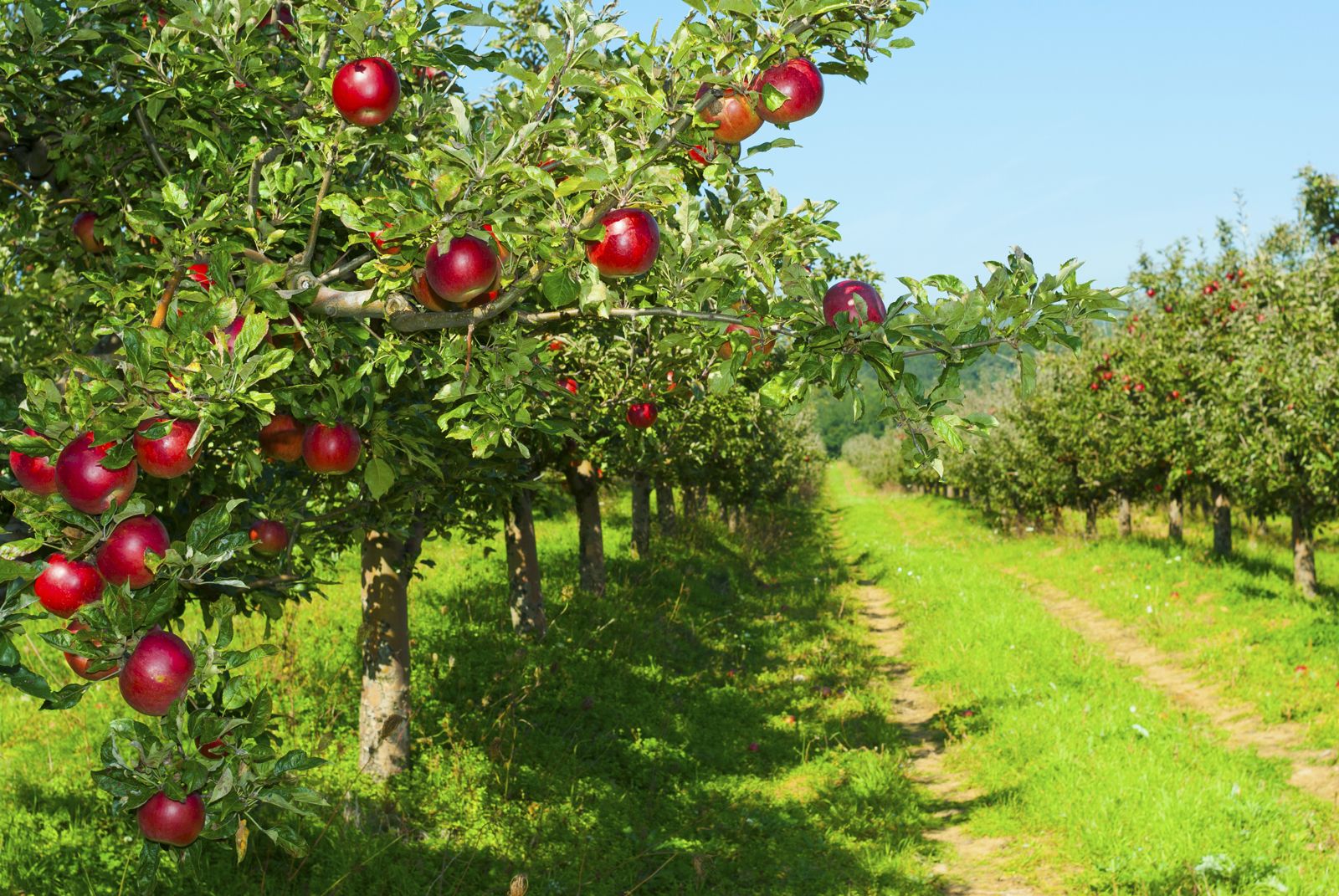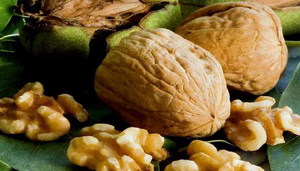 The attractive deciduous walnut tree grows in many countries of Europe and Asia Minor, in southern Kyrgyzstan and northern China. In order to get ripe fruits, in Russia until recently this heat-loving plant was bred only to the latitudes of Voronezh. But thanks to the work of breeders, it became possible to grow some tree varieties in the South Urals and in the Central region. They are distinguished by high yield, winter hardiness, excellent fruit quality, disease and pest resistance.
The attractive deciduous walnut tree grows in many countries of Europe and Asia Minor, in southern Kyrgyzstan and northern China. In order to get ripe fruits, in Russia until recently this heat-loving plant was bred only to the latitudes of Voronezh. But thanks to the work of breeders, it became possible to grow some tree varieties in the South Urals and in the Central region. They are distinguished by high yield, winter hardiness, excellent fruit quality, disease and pest resistance.
Content
Walnut: description, varieties with photos
Tall tree with a spreading crown grows up to 30 meters... The straight trunk of a tree with light gray bark reaches two meters in diameter. Complex, serrated in the upper part of the leaves 4-7 cm long, consist of 5-9 elongated leaves.
Walnut blooms with small green flowers. On the annual tops of the tree, inflorescences of 2-3 female flowers are formed. Male multi-flowered thick earrings are located in the axils of the leaves. Flowers bloom in late April - early May. A very spectacular walnut bloom lasts for 15 days.
At 8-12 years after planting, the plant enters fruiting... Its fruits, with a hard and thick skin, contain a single, four-lobed seed. They ripen in late August - early September. The size and weight of the fruit depends on the place of growth and the type of tree. The shape of the nuts can be ovoid, oval, or round. The smallest fruit weighs only 8 grams, the largest can weigh more than 12 grams.
The walnut tree brings the richest harvests at the age of about fifty years. This long-liver in garden plots can grow and bear fruit for up to two hundred years or more.
Popular varieties - photo
Today in our country is grown more than 20 varieties of walnuts... All of them are resistant to light frost, give an excellent harvest and have a pleasant taste. The most popular varieties among gardeners:
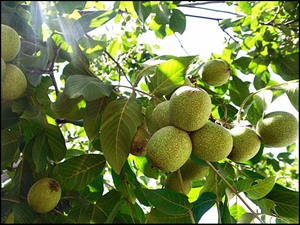 Walnut "Abundant" - the tree grows up to 5 meters and begins to bear fruit already in the fourth year after planting. The fruits are formed in clusters, each of which can consist of eight or more nuts. During the season, the plant can produce up to 30 kg of fairly large fruits with excellent taste. The Izobilny variety does not tolerate negative temperatures well. Resistant to brown spot.
Walnut "Abundant" - the tree grows up to 5 meters and begins to bear fruit already in the fourth year after planting. The fruits are formed in clusters, each of which can consist of eight or more nuts. During the season, the plant can produce up to 30 kg of fairly large fruits with excellent taste. The Izobilny variety does not tolerate negative temperatures well. Resistant to brown spot.- The variety "Urozhainy" has a wide-oval crown and grows up to 6 meters. Fruits with great taste have a mass of 9-11 grams. This is a mid-season variety on which nuts ripen by the end of September. The plant is frost-resistant and weakly susceptible to diseases.
- The "Graceful" variety is a powerful tree with a well-leafy crown. The plant grows up to five meters, bears fruit in the fifth year after planting, bears fruit at the end of September. The variety is frost-resistant, drought-resistant, has a natural immunity to various pests and diseases. Only severe frosts can damage its flower buds and wood.Under favorable growing conditions, one tree gives more than 20 kg of fruits with a weight of 11 g each.
- The Dessertny variety is a medium-sized tree that grows only up to 3 meters. It is distinguished by a spreading crown and large fruits in a powerful shell. Begins to bear fruit in the fourth year after planting. Up to 25 kg of nuts can be harvested from each plant in mid-September. The variety is drought-resistant, but does not like severe frosts, in which the bark and flower buds are affected.
- The Ideal variety is a fast-growing tree that begins to bear fruit in the third - fifth year of life. One adult plant at least 12 years old can produce up to 120 kg of fruit. The mass of each kernel reaches 10-12 g. The Ideal variety loves well-lit areas and loamy moderately moist soils. It should be planted away from buildings, since the tree's root system is very powerful.
- The Black Walnut variety grows up to 50 m and is distinguished by fruits with a dense, thick, black skin. In the tenth year, dark nuts with numerous grooves, which are larger than traditional ones, begin to ripen on the plant. The peel of this variety is very rich in vitamins. Their core contains oils, carbohydrates, proteins. The tree tolerates frost and excessive moisture well. Recommended for planting in well-lit areas. Young plants cover themselves for the winter in the first few years.
- Walnut "Memory of Minova" is an excellent early ripening variety and is very popular in our country. A powerful tree with fast growth and medium crown density. In the sixth year after planting, nuts begin to ripen on the apical branches, the weight of which can be from 15 to 18.5 grams. Slightly flattened fruits have a thin shell with a slightly silvery hue.
- The Kalashiksky variety is popular due to the excellent taste of the fruit. A tree with a rounded crown and staminate flowers blooms quite early. Large nuts weighing up to nineteen grams have a slightly ribbed, round shape. They have a flat base, a rounded top, and a dense shell.
Walnut: outdoor planting
 The plant is light-requiring, therefore it loves well illuminated areas... The distance between seedlings should be at least five meters, since mature trees have a powerful root system.
The plant is light-requiring, therefore it loves well illuminated areas... The distance between seedlings should be at least five meters, since mature trees have a powerful root system.
The walnut does not like compacted and very swampy soils. It grows well on moderately moist loams. When planting plants, manure mixed with ash must be added to the soil.
The planting pit should be 40x40 cm in size. The seedlings should be planted very carefully. When planting, their roots are laid out in a horizontal position and covered with earth. It is not recommended to deeply deepen the young plant. The upper roots should be at a depth of only 6-7 cm.
Features of walnut care
In the early years, young plants require careful maintenance.
Watering
In spring and summer, young trees need regular, abundant watering... One square meter of soil takes about three buckets of water. The seedlings are watered twice a month. Trees that have grown up to four meters can be watered less often. However, in dry summers, soil moisture must be monitored.
Top dressing
During the period of active growth, walnut trees should be fertilized. In the spring they are fed with nitrogen fertilizers, and in the fall - with phosphorus fertilizers. At the same time, fertilizing with nitrogen fertilizers is carried out only two years after planting. They are introduced carefully, since nitrogen favors the development of bacteria harmful to the plant.
A tree that has reached the age of 20 fed with fertilizers, which include:
- about 10 kg of superphosphate;
- 2 kg of potassium salt;
- 7 kg of ammonium nitrate.
Pruning
Walnut does not need to form a crown. However, dead and unnecessary branches should be cut annually. It is not recommended to do this in the spring, since the plant will lose a lot of juice and develop poorly.
Unnecessary branches trimmed in two steps and only in summer:
- In the first year, the branch is cut so that a twig is about 7 cm long.
- In the second year in summer, the twig is completely removed from the tree.
Cutting points must be treated with garden varnish.
Fruit picking
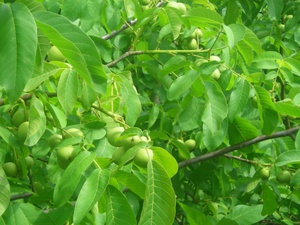 They begin to collect nuts only after the pericarp turns green and begins to crack. The collected fruits can be kept in the basement for about a week. In this case, it will be easy to clean them of the blackened and softened pericarp. Next, the nuts will need to be washed and dried in the sun.
They begin to collect nuts only after the pericarp turns green and begins to crack. The collected fruits can be kept in the basement for about a week. In this case, it will be easy to clean them of the blackened and softened pericarp. Next, the nuts will need to be washed and dried in the sun.
It is recommended to peel the fruits with rubber gloves, otherwise the hands may turn black from the iodine contained in the pericarp.
Walnut propagation
There are two ways to propagate a plant:
- Seeds.
- Vaccination.
Seed reproduction
Local varieties of nuts are selected for planting. They should be large, with a slightly cracked outer skin and no damage. The collected seeds must be dried at room temperature.
Planting soil dug up in autumn... Nuts are planted in the southern regions in early April, and in the Urals and in the central zone of the country - in mid-April.
The distance between the rows in which the sowing will be carried out should be at least 50 cm.The distance between the fruits themselves should be 15 cm.
Seed stratification is recommended before sowing. In this case, they will germinate better. For this, fruits with a thin and medium shell are kept at a temperature of + 18C for one and a half months, and nuts with a thick shell at a temperature of no more than + 7C are stratified for about a hundred days.
Walnuts sprout slowly. The seedlings will be suitable for planting only 5-7 years after sowing the seeds.
Reproduction by grafting
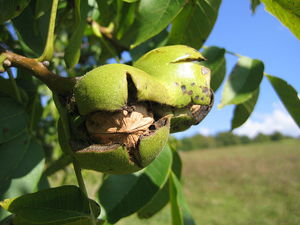 To preserve the positive qualities of the mother tree, the walnut propagated by grafting... For this, two-year-old seedlings are selected, which are planted in pots with a diameter of about 12 cm. In December, rootstock seedlings are brought into a room, where by the time of grafting they grow and give good shoots.
To preserve the positive qualities of the mother tree, the walnut propagated by grafting... For this, two-year-old seedlings are selected, which are planted in pots with a diameter of about 12 cm. In December, rootstock seedlings are brought into a room, where by the time of grafting they grow and give good shoots.
After vaccination, which is carried out in February, the plants are kept at a temperature of 24-26C. In mid-May, grafted young trees can be planted in open ground.
Having planted a walnut tree in your area, you can enjoy its flowering in spring, and fruits in autumn. It not only brings abundant harvests, but also symbolizes prosperity and wealth... In Moldova and the Caucasus, a tradition has been preserved for a long time as a dowry to plant a walnut in your area after the birth of a child.
